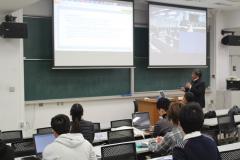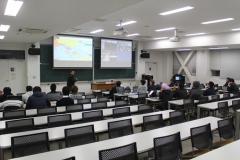
1.“The Future Challenge in Indonesian Power System Grid” 2.“Improving the Performances of Outdoor Insulators and modeling of Insulators using Leakage Current waveforms” [12月12日(水)九州工業大学]
2018/12/14
【科目種別】電気エネルギーシステム工学特論Ⅱ(英語科目)
■講師:
1. Dr. Nanang Hariyanto
2. Prof. Suwarno Harjo
( ご所属)Institut Teknologi Bandung,インドネシア
■演題:
1. “The Future Challenge in Indonesian Power System Grid”
2. “Improving the Performances of Outdoor Insulators and modeling of Insulators using Leakage Current waveforms”
■日時:平成30年12月12日(水)16:20~17:50
■場所:九州工業大学 戸畑キャンパス (C-2A教室)
遠隔講義場所
九州大学:(第7会議室)
熊本大学:(仮設D棟1階A会議室)
福岡大学:(4号館マルチメディア室)
福岡工業大学:受信なし
■主催:国立大学法人 九州工業大学 大学院 工学研究院
■協賛:大学間連携共同教育プログラム
■申込/お問合せ:九州工業大学 担当:小迫
E-mail:renkei_kit[at]ele.kyutech.ac.jp
■概要:
1.In the future of Jawa Bali Grid System, it facts that there have been some growing concerns pertaining to the long-term expansion of power generation and extension of HV/EHV network in Java-Bali Grid System. The concerns are started with the high demand growth in the past a few years and uncertainty in forecasting electricity demand into the future, uncertainties in generation capacity expansion planning and transmission network planning, as well as uncertainties in the impacts of emerging and disruptive technology to the future’s electricity system in Java-Bali. In the operation side it also recognizes that the major issues in Java-Bali power system are mostly attributed to the operating performance of the existing HV/EHV transmission network, and not so much to the generation system and dynamic small stability problems. Such issues include high short circuit currents in some parts of the network, deteriorating security for single contingency events, vulnerability to experience wide-spread disturbances for multiple but credible contingency events. In addition, advanced technologies in power transmission based on power electronics, such as FACTS or HVDC, has been thoroughly assessed by PLN to see their techno-economic viability in Java-Bali power system. The network extension has been solely planned and executed this way to respond to the immediate needs for meeting demand growth and to evacuate power from new power plants.
Despite some operational issues that have been faced by the grid operator, the existing 500 kV transmission system itself in general has been quite successful in functioning as the backbone for the whole Java power system. It allows for economic operation of the power system with reasonable security. Now the 500 kV network has evolved into a very large network, comparable to some large networks found elsewhere in the world. Several large scale power plants are connected to the 500 kV grid, and more new large power plants will be connected to the grid. Consequently, when many power plants of very large capacity are situated in a region of Java, the level of fault currents on the region would be very high. HV and EHV grids in Java-Bali have been facing increased short circuit level due to the increased number of power plants connected to the grids, and this needs to be anticipated, such as through network reconfigurations, deployment of short-circuit current limiter (SCL), introduction of a new voltage level, or use of back-to-back HVDC. Several ways of mitigating high fault current level have been recognized, such as network reconfiguration, change of the existing power plant connection to highest voltage level, use of high impedance generator transformers, installation of series reactors or short circuit current limiters (SCCL), introduction of new intermediate voltage level, introduction of ultra-high voltage level, replacement of the existing CB and/or adoption of CB with higher breaking-capacity standard, and introduction of back-to-back HVDC link. Network expansion planning will be conducted once the locations of new power plants and load centers have been identified. The emergence of variable RE would also be represented in the transmission planning models. Several options of network expansion schemes would need to be explored, including the use of more advanced technology, such as UHV, HVDC, FACTS, hydro pumped storage, BESS (battery energy storage system).
In this seminar will be presented some possible solutions, it includes (i) the possibility recommendation regarding the high short circuit fault currents in some area, using short circuit fault current limiter and it locations, and the possibility application if HVDC Back-to-Back to solve it, (ii) the strategy to solve the intermittency that in feed to the Jawa Bali Grid System.(iii) interconnection of Jawa Bali to Sumatera using HVDC link.
2.Outdoor insulator is one of the most important equipments in a high voltage transmission system. The insulator contributes to about 35 % of system failures and about 90 % of the insulator failures are caused by the insulation problem. In order to obtain high reliability power system, insulators with excellent performances are important. There are 3 kinds of outdoor insulator commonly used in a power system. They are porcelain, glasses and polymeric insulators. During operation the insulator string will interact with outside climate and pollution. Long term aging will take place and in the long time flash over may occur. In order to achieve good performance insulators in a transmission line several efforts may be done such as increasing the number of insulator string or total length of insulators, special design and selection of the most suitable insulator materials. The diagnostic and maintenance strategy are also important to enhance the performance of the insulators. In this talk, the application of the various insulators in various environmental conditions and the methods to improve their performances will be presented. Measurement of leakage current and modeling of insulator based on the leakage current will also be presented. Furthermore, simulation of leakage current to understand the behavior of outdoor insulator will also be presented.
■学生の関わり様
インドネシア国バリ島とスマトラ島間の新規電力網導入の際の送電方式,短絡電流抑制,コスト試算などの課題についてのシミュレーションに関して解説がなされ,それにつき,直流高電圧送電方式導入のメリット・デメリット,原子力発電所導入した場合の系統のありかたなど専門性の高い議論がなされた。また,バリ島などの湾岸に敷設される屋外絶縁の重汚損地区での屋外絶縁のフラッシオーバー電圧(FOV)低減現象・メカニズム,FOVの改善方法,漏れ電流モニタリングとモデル化など,解説がなされれ,高電圧絶縁に関する研究を遂行する学生もおり,大変興味深いものとなった。学生からの質問では,屋外絶縁用がいし表面への半導電層塗布の効果(実際には使用時にFOして40000台交換した),漏れ電流推定の等価回路でのアーク物理モデルの導入法,実践路への漏れ電流測定系導入の予定など多くの質問がなされ,大変有意義なものとなった。
■講師:
1. Dr. Nanang Hariyanto
2. Prof. Suwarno Harjo
( ご所属)Institut Teknologi Bandung,インドネシア
■演題:
1. “The Future Challenge in Indonesian Power System Grid”
2. “Improving the Performances of Outdoor Insulators and modeling of Insulators using Leakage Current waveforms”
■日時:平成30年12月12日(水)16:20~17:50
■場所:九州工業大学 戸畑キャンパス (C-2A教室)
遠隔講義場所
九州大学:(第7会議室)
熊本大学:(仮設D棟1階A会議室)
福岡大学:(4号館マルチメディア室)
福岡工業大学:受信なし
■主催:国立大学法人 九州工業大学 大学院 工学研究院
■協賛:大学間連携共同教育プログラム
■申込/お問合せ:九州工業大学 担当:小迫
E-mail:renkei_kit[at]ele.kyutech.ac.jp
■概要:
1.In the future of Jawa Bali Grid System, it facts that there have been some growing concerns pertaining to the long-term expansion of power generation and extension of HV/EHV network in Java-Bali Grid System. The concerns are started with the high demand growth in the past a few years and uncertainty in forecasting electricity demand into the future, uncertainties in generation capacity expansion planning and transmission network planning, as well as uncertainties in the impacts of emerging and disruptive technology to the future’s electricity system in Java-Bali. In the operation side it also recognizes that the major issues in Java-Bali power system are mostly attributed to the operating performance of the existing HV/EHV transmission network, and not so much to the generation system and dynamic small stability problems. Such issues include high short circuit currents in some parts of the network, deteriorating security for single contingency events, vulnerability to experience wide-spread disturbances for multiple but credible contingency events. In addition, advanced technologies in power transmission based on power electronics, such as FACTS or HVDC, has been thoroughly assessed by PLN to see their techno-economic viability in Java-Bali power system. The network extension has been solely planned and executed this way to respond to the immediate needs for meeting demand growth and to evacuate power from new power plants.
Despite some operational issues that have been faced by the grid operator, the existing 500 kV transmission system itself in general has been quite successful in functioning as the backbone for the whole Java power system. It allows for economic operation of the power system with reasonable security. Now the 500 kV network has evolved into a very large network, comparable to some large networks found elsewhere in the world. Several large scale power plants are connected to the 500 kV grid, and more new large power plants will be connected to the grid. Consequently, when many power plants of very large capacity are situated in a region of Java, the level of fault currents on the region would be very high. HV and EHV grids in Java-Bali have been facing increased short circuit level due to the increased number of power plants connected to the grids, and this needs to be anticipated, such as through network reconfigurations, deployment of short-circuit current limiter (SCL), introduction of a new voltage level, or use of back-to-back HVDC. Several ways of mitigating high fault current level have been recognized, such as network reconfiguration, change of the existing power plant connection to highest voltage level, use of high impedance generator transformers, installation of series reactors or short circuit current limiters (SCCL), introduction of new intermediate voltage level, introduction of ultra-high voltage level, replacement of the existing CB and/or adoption of CB with higher breaking-capacity standard, and introduction of back-to-back HVDC link. Network expansion planning will be conducted once the locations of new power plants and load centers have been identified. The emergence of variable RE would also be represented in the transmission planning models. Several options of network expansion schemes would need to be explored, including the use of more advanced technology, such as UHV, HVDC, FACTS, hydro pumped storage, BESS (battery energy storage system).
In this seminar will be presented some possible solutions, it includes (i) the possibility recommendation regarding the high short circuit fault currents in some area, using short circuit fault current limiter and it locations, and the possibility application if HVDC Back-to-Back to solve it, (ii) the strategy to solve the intermittency that in feed to the Jawa Bali Grid System.(iii) interconnection of Jawa Bali to Sumatera using HVDC link.
2.Outdoor insulator is one of the most important equipments in a high voltage transmission system. The insulator contributes to about 35 % of system failures and about 90 % of the insulator failures are caused by the insulation problem. In order to obtain high reliability power system, insulators with excellent performances are important. There are 3 kinds of outdoor insulator commonly used in a power system. They are porcelain, glasses and polymeric insulators. During operation the insulator string will interact with outside climate and pollution. Long term aging will take place and in the long time flash over may occur. In order to achieve good performance insulators in a transmission line several efforts may be done such as increasing the number of insulator string or total length of insulators, special design and selection of the most suitable insulator materials. The diagnostic and maintenance strategy are also important to enhance the performance of the insulators. In this talk, the application of the various insulators in various environmental conditions and the methods to improve their performances will be presented. Measurement of leakage current and modeling of insulator based on the leakage current will also be presented. Furthermore, simulation of leakage current to understand the behavior of outdoor insulator will also be presented.
■学生の関わり様
インドネシア国バリ島とスマトラ島間の新規電力網導入の際の送電方式,短絡電流抑制,コスト試算などの課題についてのシミュレーションに関して解説がなされ,それにつき,直流高電圧送電方式導入のメリット・デメリット,原子力発電所導入した場合の系統のありかたなど専門性の高い議論がなされた。また,バリ島などの湾岸に敷設される屋外絶縁の重汚損地区での屋外絶縁のフラッシオーバー電圧(FOV)低減現象・メカニズム,FOVの改善方法,漏れ電流モニタリングとモデル化など,解説がなされれ,高電圧絶縁に関する研究を遂行する学生もおり,大変興味深いものとなった。学生からの質問では,屋外絶縁用がいし表面への半導電層塗布の効果(実際には使用時にFOして40000台交換した),漏れ電流推定の等価回路でのアーク物理モデルの導入法,実践路への漏れ電流測定系導入の予定など多くの質問がなされ,大変有意義なものとなった。











